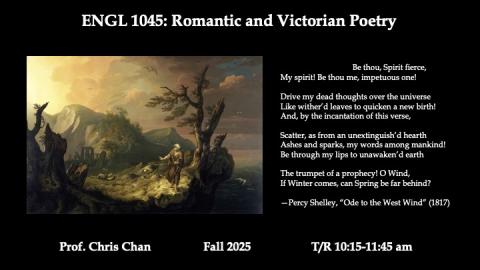This course will introduce you to poems written primarily by British poets between the advent of the Industrial Revolution (c. 1760) and the end of the First World War (1918). Encompassing the Romantic and Victorian periods, this phase of history witnessed sweeping social, political, and economic changes across Great Britain and its empire, as well as a veritable revolution in its literary culture. We’ll track these shifts by reading a wide range of poems, paying careful attention to their technical craft and imaginative scope. Beginning with a survey of popular poetic forms, we’ll then examine representative engagements across the period with several recurring themes: aesthetics, authority, identity, labor, liberty, nature, religion, and tradition. Along the way, we’ll investigate the ever-changing relationship between poetic form and function, and we’ll reflect on the ways that they continue to shape the practice and interpretation of poetry today.
Major poets for our course include Charlotte Smith, William Blake, Anna Barbauld, Samuel Taylor Coleridge, John Keats, William Wordsworth, Percy Shelley, Alfred Tennyson, Elizabeth Barrett Browning, Christina Rossetti, Toru Dutt, and Thomas Hardy. Course assignments include regular reading responses, a comparative paper or creative “translations” of two poems, and a take-home final exam or critical-creative project. No prior knowledge of the period or its poetry is required to take this course, and non-majors are welcome to attend.

 Department of English
Department of English
